- Local Organizations: Receive 10% of the total net profit, and the distribution ratio is determined according to the cooperation behavior and interests of the local organizations.
- Company: Receives 10% of net profits.
- Artist: Receives 80% of remaining net profits.
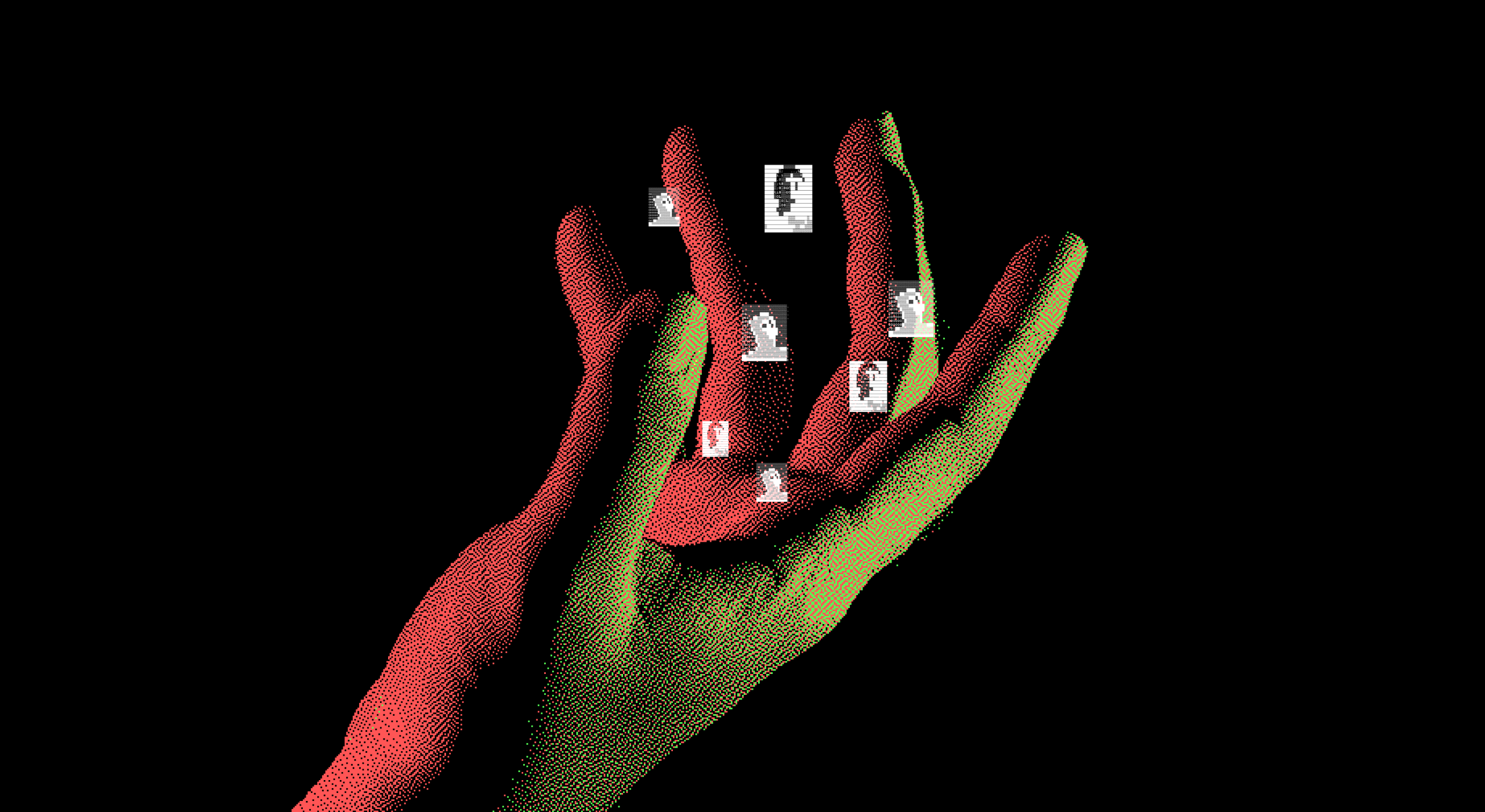
AI is not fair.
Modern large-scale artificial intelligence systems have the problem of failing to provide adequate compensation to creators and artists. Most of these systems learn by using free images or crawling large amounts of data, and creators' rights are often overlooked in the process. Advances in AI make it difficult to trace original data and tend to absorb the efforts of creators.
Some AI systems are attempting to reward creators, but most of these efforts are inadequate and have been criticized. These are mainly limited to one-time payments or small lump-sum compensation for the first use of the image and have been criticized for failing to recognize sufficient value to the creator.
In response to these problems, the Melting Pot AI project was launched. This project started with the hope that creators would use their work to inspire and be used by people, rather than just use it as AI learning material. Melting Pot AI recognizes the efforts of creators and focuses on ongoing dialogue and research on how AI developers, users, and creators can share value.
Melting Pot AI's new settlement model is the result of this research and aims to provide fairer and more appropriate compensation to creators. This system builds new connections between creators and technology and takes an innovative approach to providing creators with new opportunities and fair compensation.
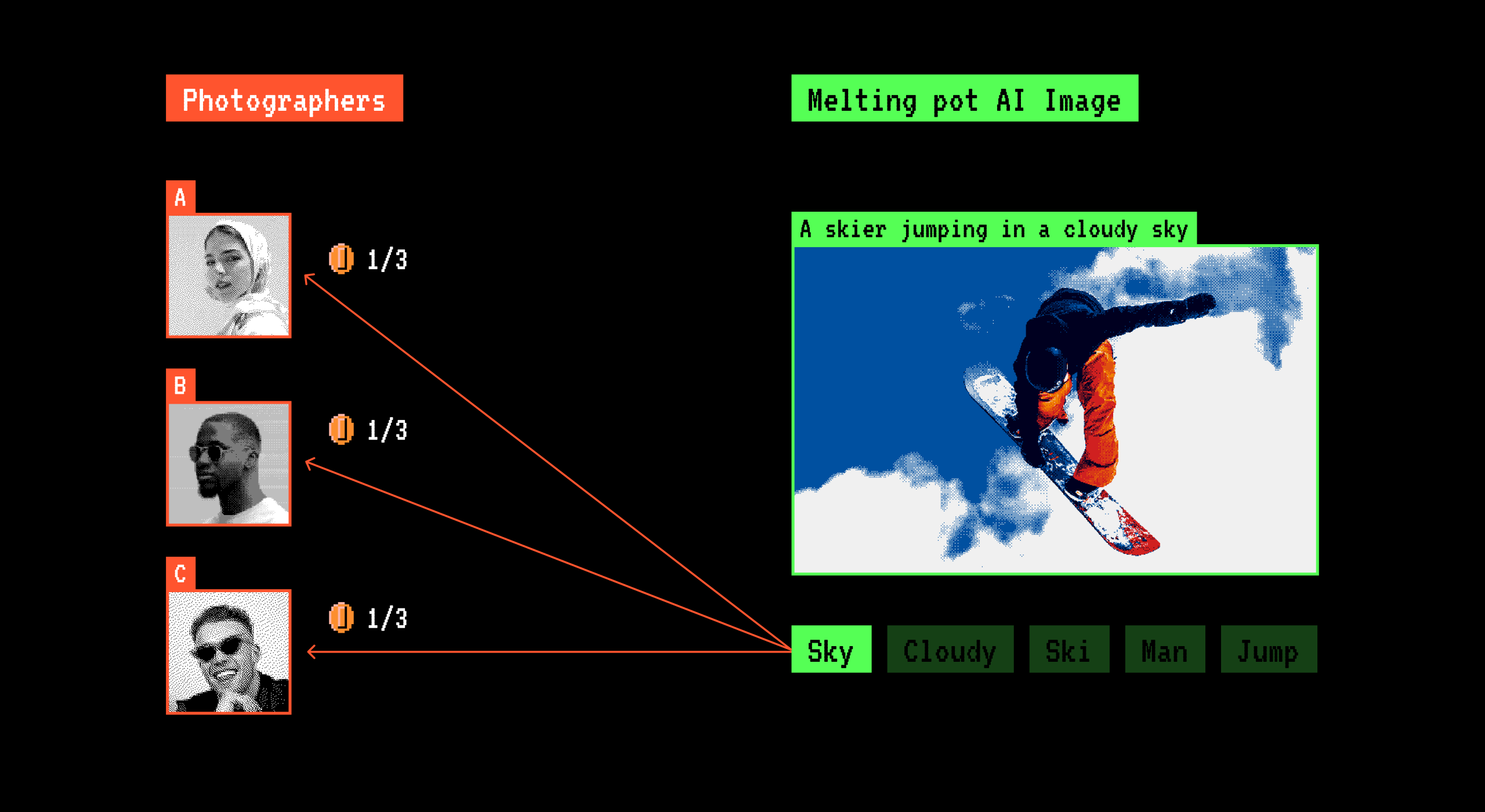
1. AI's Royalty Settlement Model - an Ecosystem Where Artists and AI Coexist
Modern large-scale artificial intelligence systems have the problem of failing to provide adequate compensation to creators and artists. Most of these systems learn by using free images or crawling large amounts of data, and creators' rights are often overlooked in the process. Advances in AI make it difficult to trace original data and tend to absorb the efforts of creators.
Some AI systems are attempting to reward creators, but most of these efforts are inadequate and have been criticized. These are mainly limited to one-time payments or small lump-sum compensation for the first use of the image and have been criticized for failing to recognize sufficient value to the creator.
In response to these problems, the Melting Pot AI project was launched. This project started with the hope that creators would use their work to inspire and be used by people, rather than just use it as AI learning material. Melting Pot AI recognizes the efforts of creators and focuses on ongoing dialogue and research on how AI developers, users, and creators can share value.
Melting Pot AI's new settlement model is the result of this research and aims to provide fairer and more appropriate compensation to creators. This system builds new connections between creators and technology and takes an innovative approach to providing creators with new opportunities and fair compensation.
2. 2-Layered Labeling for Data Learning and Settlement
Depending on how AI is used, the content of labeling and captions will vary, which is important to ensure high-quality images and detailed descriptions for AI training. However, when using AI, loyalty models are difficult to apply because users typically use general prompts rather than specific instructions.
To elaborate, one of the challenges in developing and using AI image generation models is the gap between the user's prompt and the AI's interpretation. Users often provide simple, abstract prompts, but AI must interpret them to create concrete images. During this process, developers of AI models must fine-tune the relationships between prompts and images.
For example, when a user provides the prompt “Wave your arms happily,” the AI must decide which arm movement to interpret based on this simple description. Here, AI developers need to use images of different arm movements and their labels to enable the AI to recognize and generate different arm movements. For example, AI learns different movements such as “raise arm up,” “wave arm to the side,” and “turn arm,” and generates an image that best matches the user’s prompt.
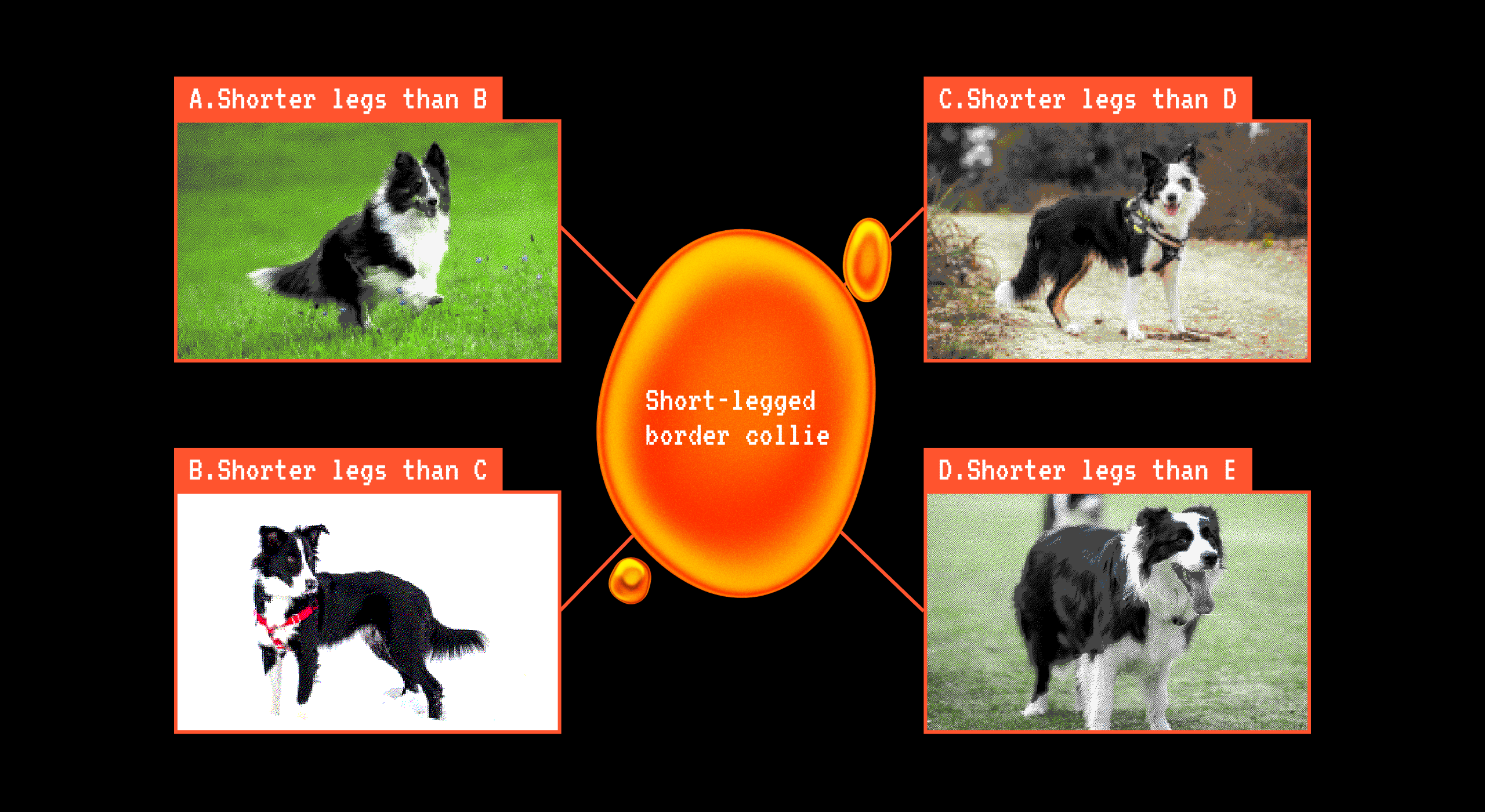
As for the prompt “short-legged border collie,” this is an example that involves a more subjective evaluation. The concept of “short legs” can be interpreted differently by different people. In this case, AI developers need to analyze various images of Border Collies and include images of Border Collies with different leg lengths so that the AI can learn various interpretations. This allows the AI to generate a Border Collie with relatively short legs among Border Collies with various leg lengths when the user provides the prompt “Border Collie with short legs.”
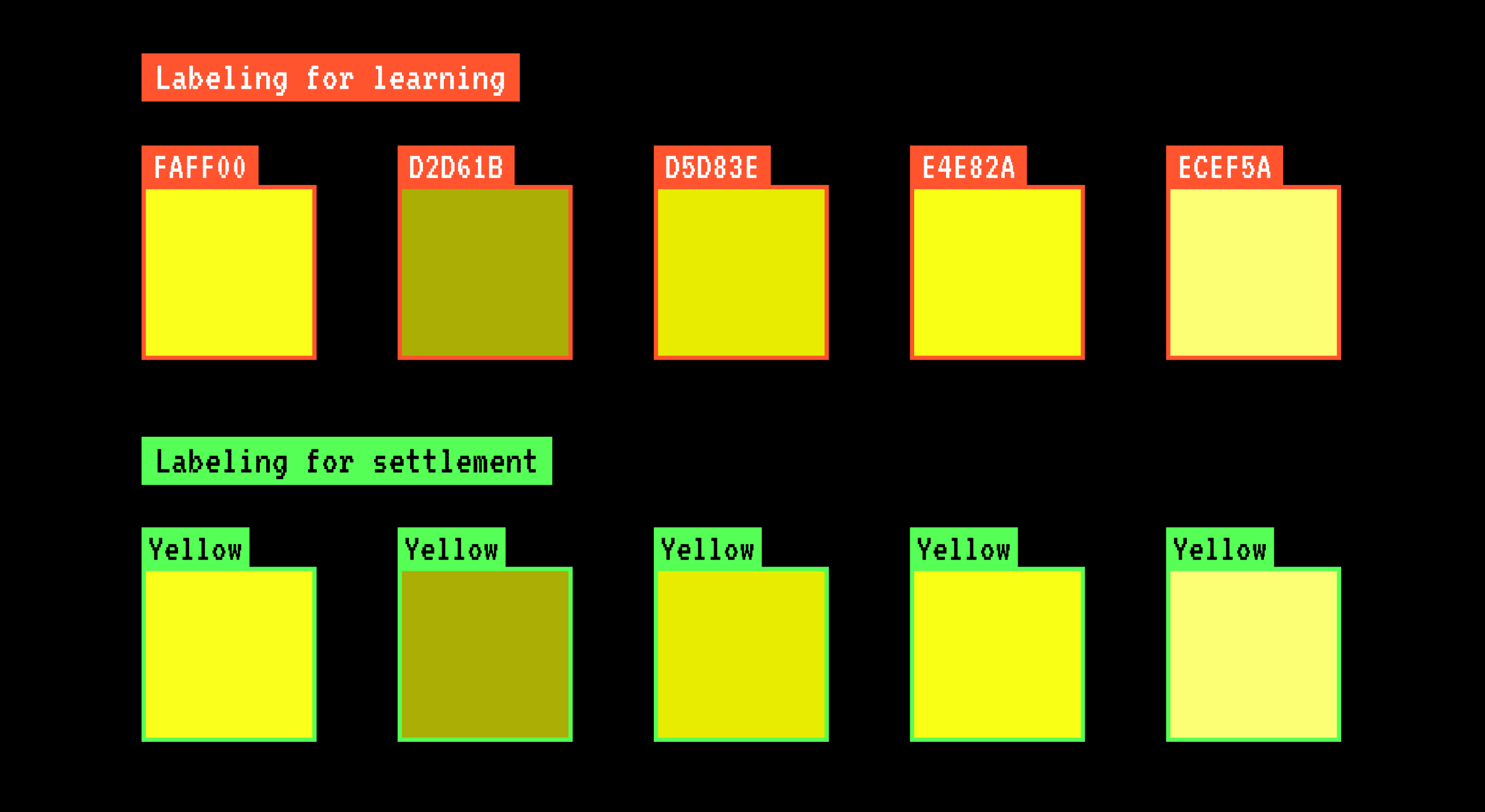
Therefore, the Melting Pot AI project adopted a 2-Layered labeling system to provide fair compensation to creators. The system processes captions and prompts associated with images at two levels: one for relatively more detailed concepts and one for less detailed concepts. This elaborately matches the correlation between data related to image creation and the results by considering both a level that AI can understand and an appropriate level of concept from a human perspective.
Here's how this compensation model works:
AI labels the images.
Labeling is done by adding the perspective of the data provider.
A human inspects the labeling and processes 2-layer labeling for compensation.
When the AI operates and generates revenue, the generated results and prompts are analyzed through vision AI.
Convert both pieces of information into 2-Layer labeling.
The settlement is distributed to the dataset that provided the concept for that label.
Critical to this process is labeling with an appropriate level of conceptualization to increase the match between the data provided and the output generated. This requires category processing of words, correlation and category processing between words within a sentence, and includes advanced LLM prompting technology that converts prompts for creation into words and sentences of an appropriate level. Through this technology, Melting Pot AI seeks to provide AI sovereignty to artists and maintain stability in the market by ensuring a fair distribution of profits generated from AI to creators. This approach is described publicly, and the project team and community are working to further develop the technology and bring it closer to ‘absolute fairness’.
3. Collaborating with Artists to Improve Dataset Quality
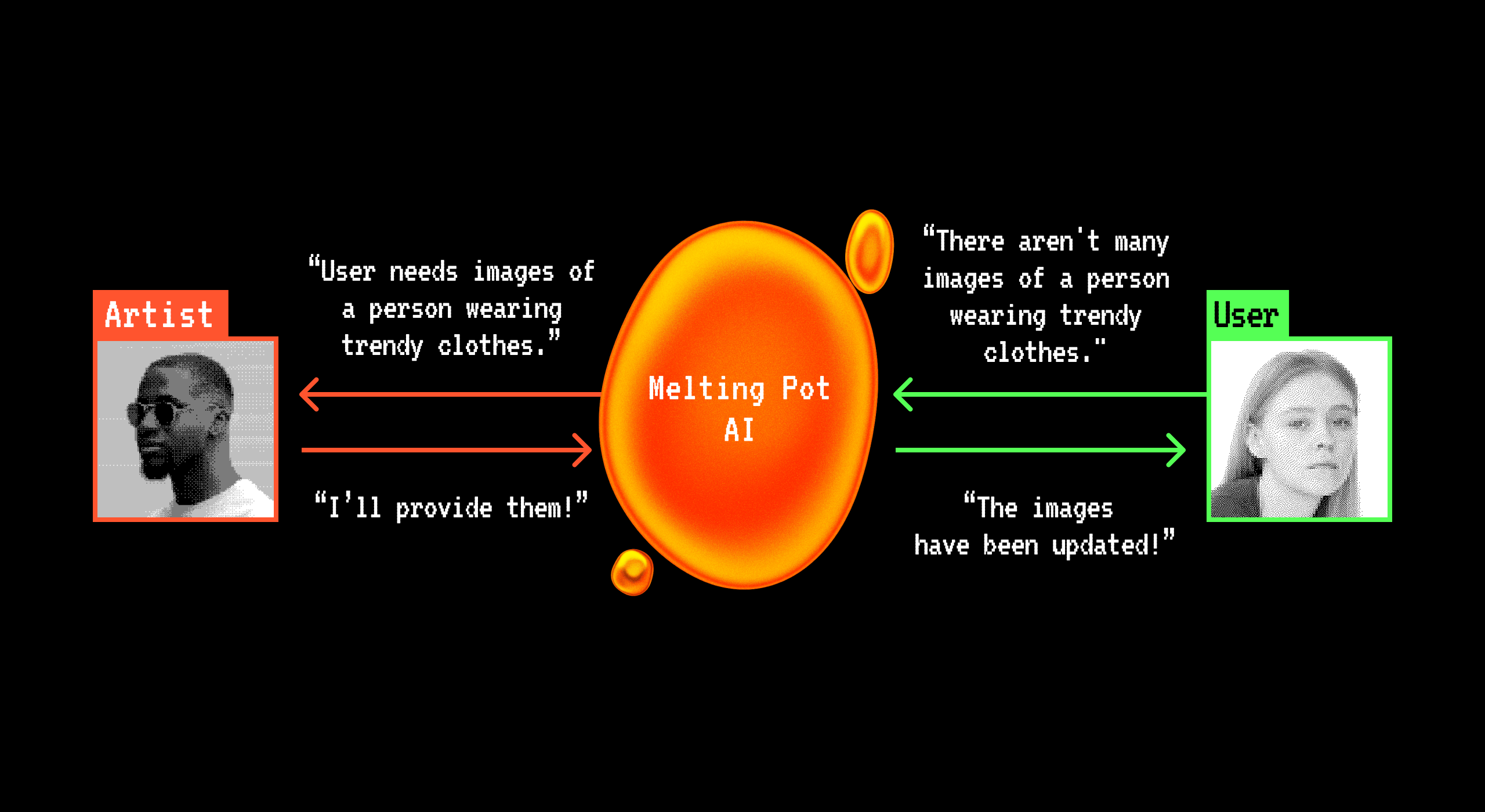
The Melting Pot AI Project seeks to improve the quality of AI datasets through collaboration with artists and improve AI performance by enabling continuous updates. This approach allows AI to reflect diversity and realism, providing results that better match the user's intent.
For example, let's say there's a problem with current AI systems failing to properly represent people of a certain race. In this case, you can identify missing datasets based on user feedback and ask people who have the images you need to provide data. In this way, you can quickly improve your dataset and increase the accuracy and diversity of your AI.
What AI needs to accurately understand human intent is an appropriate and diverse dataset. Datasets created through collaboration between artwork and AI experts must be more sophisticated, more reliable, and continuously updated. For example, to generate “a person wearing trendy clothes” with AI, up-to-date image data is needed. Without data beyond 2020, AI will only generate images that reflect trends from 2020.
Collaborating with artists means more than just settlement. This provides the opportunity to create unique AI that is continuously updated and reflects reality. Additionally, if there is excessive data for a concept, you can organically optimize the dataset by cleaning or deleting that data.
Melting Pot AI is an AI ecosystem developed based on a loyalty model. This model provides a structure that allows artists to naturally enrich AI datasets and improve performance by adding new data or reorganizing or deleting old datasets. Artists can also increase their payouts in the royalty model by providing more detailed information about their artworks. This approach aims to achieve both fairness and performance improvement.
4. Cost Settlement
We will summarize the explanation of Melting Pot AI's profit distribution system. This system is designed to distribute revenue fairly between artists, local organizations, project teams, and companies. The roles of each part and how profits are distributed are as follows:
1. Project and Project Team Roles:
- Helping artists protect their data sovereignty and maintain influence in the AI market.
- Carrying out relevant administrative and legal activities.
- Enlightening the use of AI in compliance with the new AI copyright.
2. How You Earn:
- Melting Pot AI provides services through API.
- Agreement methods include personal use, enterprise agreements with discounted rates based on usage, and more.
3. Profit Distribution Recipients:
- Artist: Provides training data to Melting Pot AI and receives royalties through 2-Layered labeling and settlement technology.
- Local Organizations: Receive funding to support local artists, local-specific labeling, support enactment of AI-related laws, administrative support, and promote and campaign for the new AI copyright law.
- Project Team: Settlement of system development and advancement of the platform, system infrastructure for AI construction, server costs, and legal and administrative costs.
- Company: Receives a portion of net profits to attract investment and increase valuation.
4. Revenue Distribution Method:
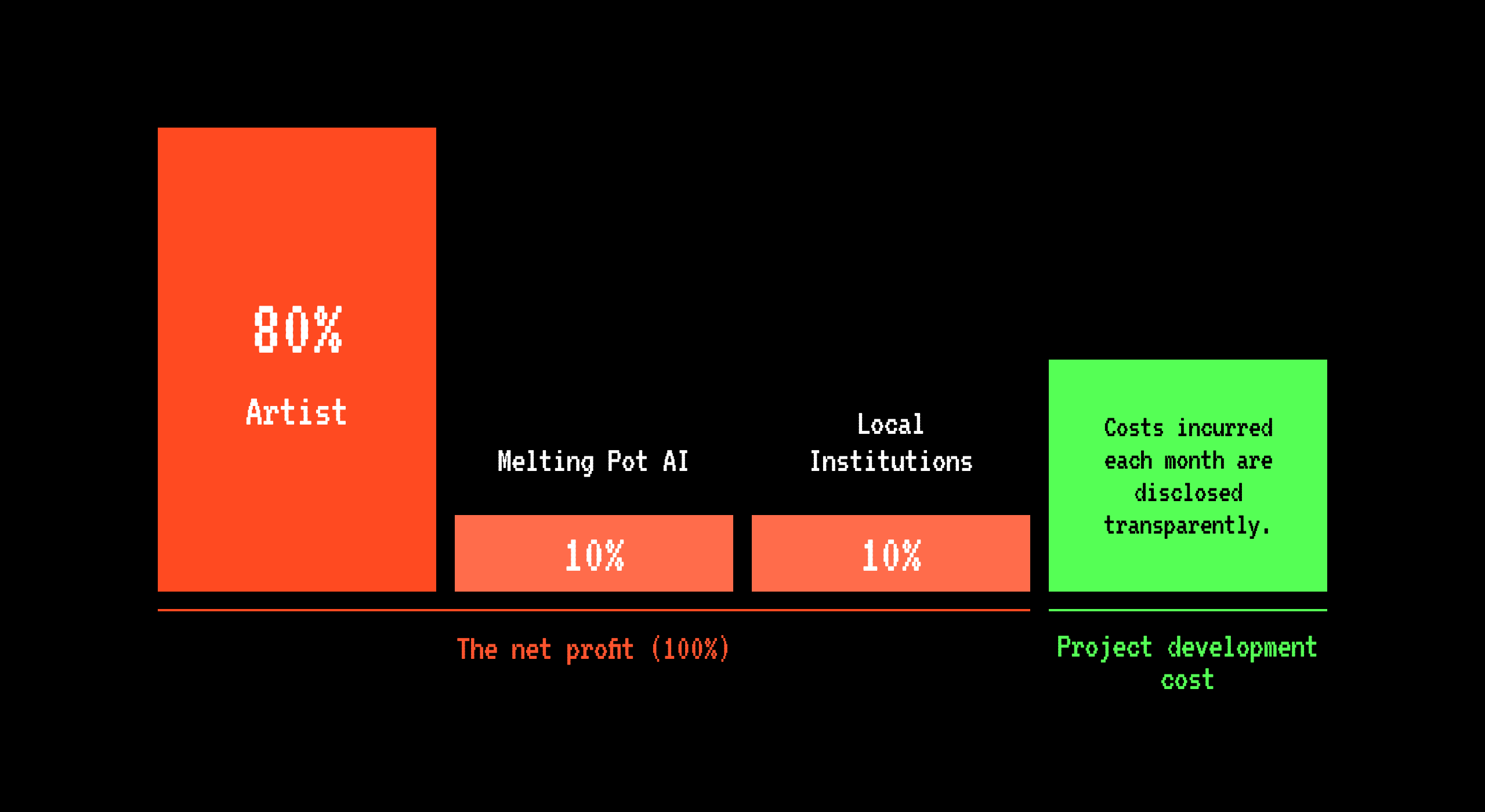
- The net profit is distributed after deducting the project team's costs from the overall profit.
- Costs incurred each month are disclosed transparently.
- Important issues are decided through community voting.
- A profit-sharing system will be implemented starting from the service of paid products (paid API). Previously, it was run on investment and company funds.
5. Profit distribution ratio for each entity:
6. Settlement Rate Adjustment Procedure:
- If the settlement rate seriously affects the operation of the project team, we will share relevant information through the community.
- We democratically re-adjust the settlement ratio together with the artists.
- This process is carried out fairly and transparently, reflecting the opinions of all stakeholders.
The system focuses on protecting artists' rights and recognizing the contributions of local organizations and project teams, while supporting the company's sustainable growth and attracting investment. Additionally, transparency and community participation in the revenue distribution process provide opportunities for all stakeholders to participate in a fair process and contribute to decision-making. This also contributes to strengthening the transparency and collaborative culture pursued by Melting Pot AI.
Melting Pot AI projects are technically complex and require significant computing power. This is essential for the continued advancement and optimization of settlement methods and may consequently require more computing resources. These technical requirements also have cost implications, which can lead to increased service costs. However, these costs can be understood as ‘valuable consumption’ rather than simple expenditure.
Melting Pot AI does not simply choose to use unethical AI to reduce costs but pursues the use of AI that is fair and has legitimate value. We want to convey the importance of conscious consumption to users and take the lead in improving awareness of society as a whole. This project seeks to work with artists to set a new standard for the use of AI. This is a movement that goes beyond technological advancement and involves all stakeholders and artists working together to improve awareness of AI and participate in legislative activities and standard setting to protect artists' rights.
The Melting Pot AI Project will continue to strive to realize this vision, and in this process, we will listen to the voices of all stakeholders and move toward a common goal. Together, we will create a sustainable and fair future for AI.